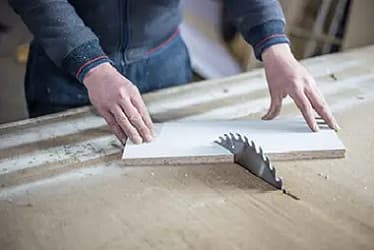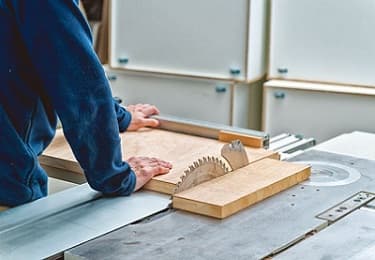As an Amazon Associate, I earn from qualifying purchases.

This guide will show you how to cut angles on a table saw. By following these steps, you can create beautiful, accurate cuts that will help your project move along more smoothly.
Understanding Angles
Before you start cutting, it’s essential to understand the basics of angles. In woodworking, angles are measured in degrees. A straight line is considered to be 0 degrees, while a right angle is 90 degrees.
Types of Angles
There are two types of angles you may encounter when cutting wood:
Acute Angles
An acute angle is an angle that measures less than 90 degrees. When cutting acute angles on a table saw, you will need to adjust the blade tilt and fence position.
Obtuse Angles
An obtuse angle is an angle that measures more than 90 degrees. When cutting obtuse angles on a table saw, you will need to make multiple cuts and join them together.
Contents
Preparing The Table Saw

Before you start cutting, it’s important to ensure your table saw is set up correctly. Here are some steps to follow:
Step 1: Check The Blade
Make sure the blade is sharp and in good condition. A dull blade can cause kickback and other safety hazards.
Step 2: Adjust The Blade Height
Adjust the blade height to match the thickness of the wood you’re cutting.
Step 3: Adjust The Blade Tilt
If you’re cutting an acute angle, adjust the blade tilt to the desired degree.
Step 4: Adjust The Fence
Adjust the fence position to match the width of the wood you’re cutting.
Cutting Acute Angles

Cutting acute angles on a table saw involves adjusting the blade tilt and fence position. Here are the steps to follow:
Step 1: Mark The Wood
Using a protractor, mark the angle on the wood.
Step 2: Adjust The Blade Tilt
Adjust the blade tilt to match the angle on the wood.
Step 3: Adjust the Fence
Adjust the fence position to align with the blade.
Step 4: Make The Cut
Hold the wood firmly against the fence and push it through the blade. Make sure to wear safety gear such as goggles and ear protection.
Cutting Obtuse Angles
Cutting obtuse angles on a table saw involves making multiple cuts and joining them together. Here are the steps to follow:
Step 1: Mark The Wood
Using a protractor, mark the angle on the wood.
Step 2: Make The First Cut
Adjust the blade tilt and make the first cut on one side of the angle.
Step 3: Flip the Wood
Flip the wood over and adjust the blade tilt to the opposite angle. Make the second cut on the other side of the angle.
Step 4: Join The Cuts
Join the two cuts together using glue and clamps.
Tips For Safe And Accurate Cuts

Cutting angles on a table saw can be hazardous if you’re not careful. Here are some tips to keep in mind:
- Always wear safety gear such as goggles and ear protection.
- Keep your hands and fingers away from the blade.
- Use a push stick to guide the wood through the blade.
- Keep the blade guard in place.
- Make sure the wood is flat against the fence before making the cut
- Before making any adjustments or cuts, ensure that the saw is powered off and unplugged. Safety should always be the top priority.
- Measure and mark the wood carefully using a reliable measuring tool, such as a combination square or a protractor. Accurate marking is crucial to achieving the desired angle.
- Double-check the angle measurements before proceeding with the cuts. It’s better to be cautious and ensure accuracy rather than rushing into the process.
- Take your time when aligning the wood against the fence. The wood should be firmly pressed against the fence to avoid any movement during the cutting process.
- Use a mitre gauge for better control and stability when making angled cuts. A mitre gauge provides a secure guide for the wood and helps maintain the desired angle.
- When making the cut, apply steady and even pressure on the wood to ensure a smooth and precise cut. Avoid rushing or forcing the wood through the blade, as this can lead to inaccurate cuts and potential kickback.
- Once the cut is complete, inspect it for accuracy. Use a square or another measuring tool to verify that the angle matches your intended measurement.
- If you’re not satisfied with the cut or need to make adjustments, avoid altering the angle on the blade while the saw is running. Always power off the saw, make the necessary adjustments, and then recheck the angle before proceeding.
- Regularly maintain and clean your table saw to ensure its optimal performance. Clean the blade, tabletop, and other components regularly, and keep the saw properly calibrated for accurate cuts.
Remember, practice makes perfect. Cutting angles on a table saw may require some trial and error initially, but with time and experience, you’ll become more proficient at achieving precise and clean cuts.
FAQs
Can I use a circular saw instead of a table saw for cutting angles?
While a circular saw can be used to cut angles, a table saw provides better stability and control for accurate cuts. However, if a table saw is not available, a circular saw with a guide or jig can be an alternative.
What type of blade should I use for cutting angles on a table saw?
A general-purpose combination blade with a high tooth count is suitable for most angle-cutting tasks. However, for specific materials or applications, specialized blades such as crosscut blades or rip blades may be preferred.
Are there any alternative methods for cutting obtuse angles without joining multiple cuts?
Yes, one alternative is to use a compound mitre saw, which allows you to tilt the blade to cut both sides of the angle in a single pass. This method eliminates the need for joining multiple cuts.
What should I do if the wood gets stuck or pinched during the cut?
If the wood gets stuck or pinched, do not force it through the blade. Turn off the saw and carefully remove the wood, ensuring your hands are clear of the blade. Check for any obstructions or misalignments before attempting the cut again.
Can I cut angles on a portable table saw?
Yes, portable table saws can also be used for cutting angles
Conclusion
Cutting angles on a table saw is a fundamental skill for any woodworking enthusiast or professional. By understanding the types of angles, preparing the table saw correctly, and following the step-by-step instructions for cutting acute and obtuse angles, you can achieve accurate and high-quality cuts. Always prioritize safety by wearing appropriate protective gear and following safe operating procedures. With practice and attention to detail, you’ll be able to tackle woodworking projects that require precise angles confidently.



